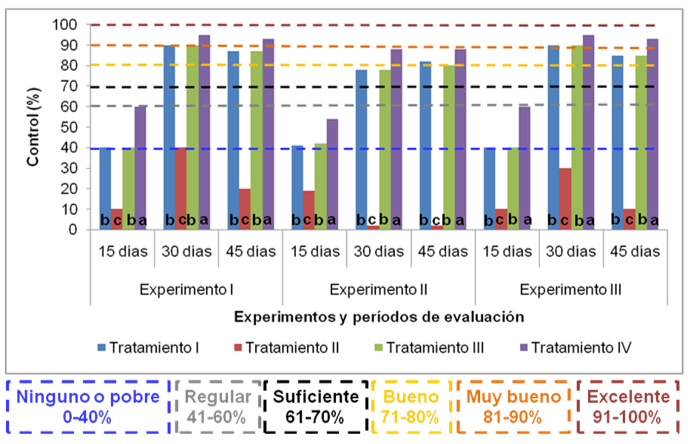Evaluación de ASULAM LS 40 con trifloxisulfuron sódico GD 75 en control del Sorghum halepense (L.)
Contenido principal del artículo
Resumen
Sorghum halepense (L.) Pers. es la segunda especie de arvense más frecuente en las plantaciones de caña de azúcar en Cuba, donde es localizada principalmente en la zona centro occidental. Uno de los métodos de control empleados es el químico, con el uso de Asulam. Teniendo en cuenta lo anterior, el objetivo de este trabajo fue evaluar la efectividad de Asulam LS 40, producido por United Phosphorus Limited, mezcladocon trifloxisulfuron sódico GD 75 para el control de S. halepense, en tratamiento postemergente. Se realizaron tres experimentos en áreas de retoños en condiciones de secano y con diferentes variedades en dos tipos de suelos. Se evaluaron tres tratamientos con diferentes dosis de Asulam, mezclado con trifloxisulfuron sódico, en dosis única, comparados con el tratamiento establecido como norma en el país, en calidad de testigo. Se evaluaron el porcentaje de control de S. halepense y el efecto fitotóxico sobre el cultivo, a los 15, 30 y 45 días después de la aplicación. Se realizaron análisis de varianza clasificación doble, previa transformación de los datos, y prueba de rangos múltiples de Duncan, para la separación de las medias; ambos al 5% de probabilidad de error; con el uso del programa SPSS, Versión 17.0. El mejor resultado en el control de S. halepense se alcanzó con la mezcla de Asulam LS 40 a 5 L ha-1 con trifloxisulfuron sódico GD 75 a 0,04 kg ha-1. No se observaron daños fitotóxicos causados por los diferentes tratamientos evaluados en ninguno de los cultivares empleados.
Detalles del artículo

Esta obra está bajo una licencia internacional Creative Commons Atribución-NoComercial 4.0.
Citas
ALAM. (1974). Resumen del panel sobre métodos de evaluaci6n de control de malezas. Congreso de la Asociación Latinoamericana de Malezas, 1-48.
Ciba-Geigy, S. (1981). Manual para ensayos de campo en protección vegetal. Suiza, Wener Puntener. P, 597.
Gallego, R., Martínez, R. R., & Zuaznábar, Z. R. (2019). Eficacia de ALION PRO SC 51.75 (metribuzín + indaziflam) y tolerancia del cultivo de la caña de azúcar. XV Congreso Internacional sobre azúcar y derivados de la caña. Sección malezas, herbicidas y maduradores, La Habana, Cuba. http://www.icidca.cu
Gallego, R., Zuaznábar, R., Martínez, R., & Rodríguez, L. (2020). Manual para el manejo de arvenses asociadas al cultivo de la caña de azúcar en Cuba.
García, I., Sánchez, M., & Otero, Y. (2018). Determinación de la compactación por impactos críticos del penetrómetro en caña de azúcar. Revista Cuba y Caña, 51(1), 45-55. ISSN: 1028-6527.
González, F. (2017). Control de sorgo de alepo (Sorghum halepense (L.) Pers.) resistente a Glifosato (RG) en diferentes periodos de barbecho químico en la región Centro Norte de Córdoba. Universidad Nacional de Córdoba. Facultad de Ciencias Agropecuarias. https://rdu.unc.edu.ar/bitstream/handle/11086/5993/Gonz%c3%a1lez%2c%20Federico%20-%20Control%20de%20Sorgo%20de%20alepo%20%28Sorghum%20ha%20lepense%20%28L.%29%20Pers.%29%20Resistente%20a%20Glifosato%20%28RG%29....pdf?sequence=1&isAllowed=y
Hernández, J. A., Pérez, J. J. M., Mesa, N. Á., Bosch, I. D., Rivero, L., & Camacho, E. (1999). Nueva versión de la clasificación genética de los suelos de Cuba.: Vol. I (Barcaz L L). AGRINFOR. ISBN: 959-246-022-1.
Holm, L. G., Plucknett, D. L., Pancho, J. V., & Herberger, J. P. (1977). The world’s worst weeds. Distribution and biology. University press of Hawaii.
IUSS Working Group WRB. (2006). World Reference Base for Soil Resources 2006 (p. 128) [World Soil Resources Reports, no. 103]. FAO, first update 2007.
Martínez, R., Zuaznábar, R., Gallego, R., Rodríguez, L., Fernández, C., & León, P. (2015). Cambios en la frecuencia de las especies de malezas asociadas al cultivo de la caña de azúcar en Cuba en los últimos cinco años de cultivo. Revista ATAC, 76(2), 12-15. ISSN: 0138-7553.
Ortiz, A., Martínez, L., Quintana, Y., Pérez, P., & Fischer, A. (2014). Resistencia de la paja johnson [Sorghum halepense (L.) Pers.] A los herbicidas nicosulfuron y foramsulfuron+ iodosulfuron en Venezuela. Bioagro, 26(2), 71-78. ISSN: 1316-3361.
Rodríguez, C. N., Ricardo, N. E., Díaz, J. C., Espino, A., Fuentes, A., Rodríguez, A., & Pérez, D. (2005). Principales malezas en los cañaverales de Cuba (Primera edición). PUBLINICA.
Rodríguez, S., Rodríguez, I., Alfonso, O., Alomá, J., Pérez, C., & Romero, C. (1985). Manual de malezas de la caña de azúcar en Cuba. Plant Protection Division (ICI).
SERCIM. (2018). Manual de procedimientos (primera). PUBLINICA, Grupo Azucarero. Instituto de Investigaciones de la Caña de Azúcar, La Habana, Cuba.
Stocco, M. C. I., Lampugnani, G. A., Abramoff, C., Zuluaga, M. S., Stenglein, S. A., Acciaresi, H. A., & Mónaco, C. I. (2018). Fusarium oxysporum, potencial agente de control biológico para Sorghum halepense en Argentina. Revista de la Facultad de Agronomía, La Plata, Argentina, 117(1), 61-67.
Viera, B. F. J., & Escobar, C. L. (2015). Evaluación de mezclas de herbicidas en el control de arvenses en el cultivo de la caña de azúcar en tres tipos de suelos de Majibacoa, Las Tunas. Cultivos Tropicales, 36(1), 122-128.
